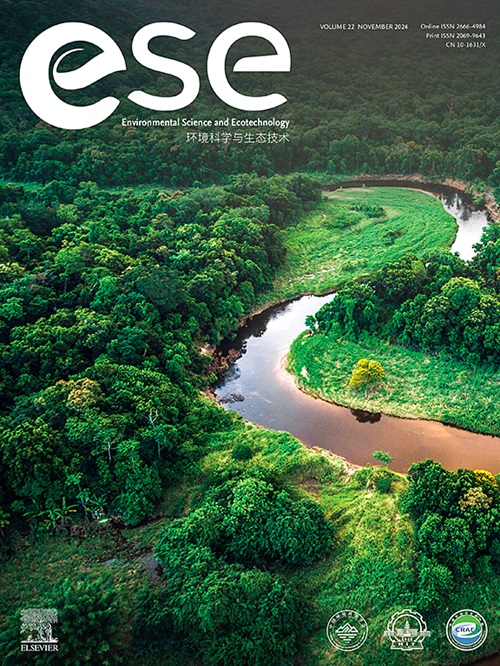保护草地生物质生物源活性炭去除城市污水中的有机微污染物
IF 14.3
1区 环境科学与生态学
Q1 ENVIRONMENTAL SCIENCES
引用次数: 0
摘要
活性炭(ACs)广泛应用于废水深度处理中,以去除逃避常规生物处理的有机微污染物(OMPs),包括药物。然而,以化石煤为基础的ac产生了大量的二氧化碳排放,与循环生物经济目标相冲突。在这里,我们通过评估未充分利用的草地生物量产生的生物源ac来解决可持续吸附剂开发的关键研究空白。采用预处理富集碳、减少矿物质的方法,从湿草甸(wet)和果园草甸的残留物中生成生物源ACs,并将其与Norit SAE Super和PULSORB WP 235进行批量吸附试验。尽管其矿物和灰分含量较高,比表面积较低,但100%活化的湿法(WET100)结合了平衡的微孔和介孔产生的非均相吸附位点,符合Freundlich等温线,并且在剂量为~ 13 mg L−1时达到50%的OMP去除率,与Norit SAE Super (~ 12 mg L−1)相当。OMP去除率与254 nm (UVA254)紫外吸光度的强相关性R2的在0.95)验证UVA254作为快速监测代理。温室气体足迹分析显示,用we100代替煤基AC,每吨吸附剂可减少约2.4吨二氧化碳当量的排放,当大规模部署用于先进的OMP去除时,可节省高达94%的二氧化碳当量。这些研究结果强调,生物源活性炭可以无缝集成到现有的处理基础设施中,使未充分利用的草地生物量稳定下来,符合循环经济和欧盟的可持续发展目标,与煤基吸附剂相比,可以节省大量温室气体。本文章由计算机程序翻译,如有差异,请以英文原文为准。

Biogenic activated carbons from conservation grassland biomass for organic micropollutants removal in municipal wastewater
Activated carbons (ACs) are widely used in advanced wastewater treatment to remove organic micropollutants (OMPs), including pharmaceuticals, that evade conventional biological processes. Yet, fossil coal-based ACs generate substantial CO2 emissions and conflict with circular-bioeconomy objectives. Here, we address the critical research gap in sustainable sorbent development by evaluating biogenic ACs produced from underutilized grassland biomass. Using a pretreatment to enrich carbon content and reduce minerals, we generated biogenic ACs from wet meadow (WET) and orchard meadow residues and compared them to Norit SAE Super and PULSORB WP 235 in batch adsorption tests. Despite its higher mineral and ash contents and lower specific surface area than conventional ACs, 100 %-activated WET (WET100) combined balanced micro- and mesoporosity—yielding heterogeneous adsorption sites that conform to Freundlich isotherms—and achieved 50 % OMP removal at a dosage of ∼13 mg L−1, on par with Norit SAE Super (∼12 mg L−1). Strong correlations between OMP removal and ultraviolet absorbance at 254 nm (UVA254; R2 > 0.95) validate UVA254 as a rapid monitoring proxy. Greenhouse gas footprint analyses revealed that substituting coal-based AC with WET100 reduces gate-to-grave emissions by approximately 2.4 t CO2e per tonne of sorbent—translating to potential savings of up to 94 % CO2e when deployed at scale for advanced OMP removal. These findings underscore that biogenic ACs can be seamlessly integrated into existing treatment infrastructure, valorize underutilized grassland biomass, align with circular-economy and EU sustainability objectives, and deliver substantial greenhouse-gas savings compared to coal-based adsorbents.
求助全文
通过发布文献求助,成功后即可免费获取论文全文。
去求助
来源期刊

Environmental Science and Ecotechnology
Multiple-
CiteScore
20.40
自引率
6.30%
发文量
11
审稿时长
18 days
期刊介绍:
Environmental Science & Ecotechnology (ESE) is an international, open-access journal publishing original research in environmental science, engineering, ecotechnology, and related fields. Authors publishing in ESE can immediately, permanently, and freely share their work. They have license options and retain copyright. Published by Elsevier, ESE is co-organized by the Chinese Society for Environmental Sciences, Harbin Institute of Technology, and the Chinese Research Academy of Environmental Sciences, under the supervision of the China Association for Science and Technology.
 求助内容:
求助内容: 应助结果提醒方式:
应助结果提醒方式:


